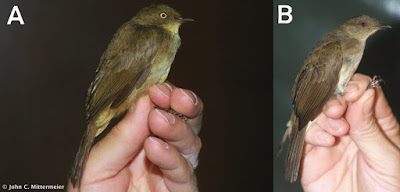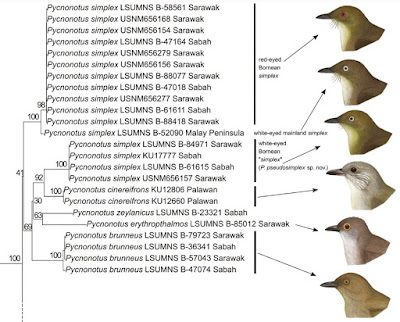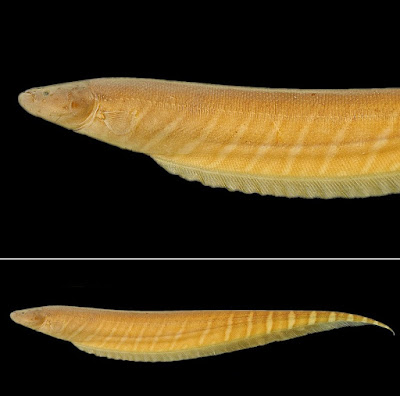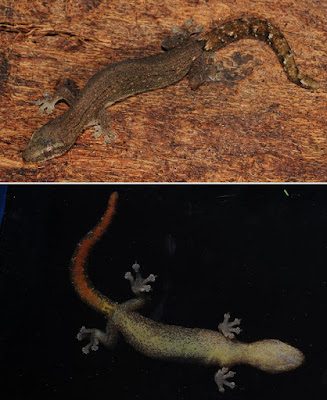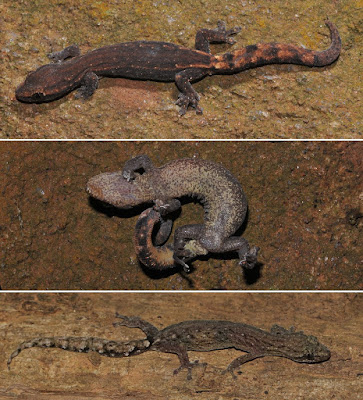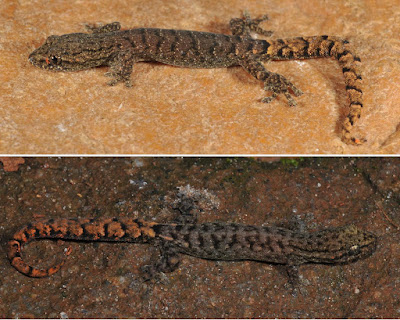[Most Recent Entries] [Calendar View]
Sunday, March 17th, 2019
| Time | Event | ||||||||
| 4:45a | [Ornithology • 2019] Pycnonotus pseudosimplex • A Cryptic New Species of Bulbul (Pycnonotidae) from Borneo
Abstract Cream-vented Bulbul Pycnonotus simplex of Borneo was previously considered to be polymorphic in iris colour, having either red or white (creamy-yellow) irides. Mitochondrial DNA sequence comparisons, however, indicate that white- and red-eyed Bornean individuals are not closely related to one another. Instead, white-eyed birds are sister to Ashy-fronted Bulbul P. cinereifrons of Palawan Island, in the south-west Philippines, and red-eyed birds are sister to white-eyed P. simplex of the Thai-Malay Peninsula. Consequently, we elect to treat the white-eyed Bornean population as a distinct, previously overlooked species. In respect to plumage, white- and red-eyed individuals are almost identical, varying only slightly in the amount of yellow coloration in their feathers. The two taxa are sympatric at some localities, but white-eyed individuals are rarer and more consistently associated with mature forest than red-eyed birds. Taxonomy.— Genetic comparisons using mitochondrial ND2 sequences reveal that white- and red-eyed individuals of P. simplex from Borneo are not members of the same species. Their segregation by iris colour is backed by a deep ND2 sequence divergence (14%). Red-eyed Bornean birds are sister to white-eyed P. s. simplex of the Thai-Malay Peninsula at 4% ND2 divergence, whereas white-eyed Bornean birds are sister to P. cinereifrons of Palawan at 12% ND2 divergence. The perfect association of ND2 haplotype with iris colour across the region where the two morphotypes co-occur suggests assortative mating and the absence of mitochondrial gene introgression. For the red-eyed Bornean population, iris colour difference is adequate for recognition as a separate subspecies (P. s. perplexus; Chasen & Kloss, 1929, Eaton et al. 2016), or possibly even species, from white-eyed P. s. simplex of the Thai-Malay Peninsula and Sumatra. Because the two taxa are relatively closely related in respect to ND2 distance, species-level reclassification should depend on future research into gene flow and song. Plumage variation is unlikely to be helpful because of the similarity between these populations and the tendency for colours to change in museum specimens (Hoogerwerf 1966, Mees 1986). For the white-eyed Bornean population, its large genetic distance from P. cinereifrons and distinct morphology (Fig. 2) are sufficient to recognise it as a species. There are no other taxa whose names apply to the Bornean white-eyed population. P. simplex subspecies have been described from Sumatra, the Anamba Islands, the northern Natuna Islands, the southern Natuna Islands, Java, and northern Borneo (Table 1, Fig. 1). Iris colour and size connect white-eyed populations of Sumatra and mainland Asia in subspecies simplex (Fig. 1). Larger size distinguishes the white-eyed subspecies halizonus (including its junior synonym axanthinus) of the Anamba and northern Natuna Islands from other white-eyed populations: e.g., mean wing length for halizonus 83.6 mm (n = 4) vs. 74 mm (n = 12) for Bornean white-eyed individuals. The red-eyed subspecies on the southern Natuna Islands (oblitus) belongs with Borneo's red-eyed population based on iris colour, size and plumage (Mees 1986). Eye colour of the Javan population (prillwitzi) varies from red to orange or red-brown, and its plumage is more distinctive than any other population of P. simplex, including red- and white-eyed Bornean populations (Hoogerwerf 1966). Apart from these taxa of P. simplex, there is no evidence that early taxonomists confused other species of similar-looking bulbuls with the white-eyed Bornean population of P. simplex. Pycnonotus brunneus has two subspecies: P. b. brunneus (including P. b. zaphaeus) and P. b. zapolius. Both of these were described as having red irides. P. erythropthalmos (including P. e. salvadorii, sometimes recognised for Borneo) has a red iris with a yellow eye-ring. Because no name applies to the Bornean white-eyed population, we name it: Pycnonotus pseudosimplex, sp. nov. Cream-eyed Bulbul Diagnosis.—The iris of P. pseudosimplex is creamy yellow instead of crimson-red as in Cream-vented Bulbul P. s. simplex of Borneo. Its plumage also differs from that of P. s. simplex in being yellower on the throat and vent, creating greater contrast with the darker breast and flanks. From P. cinereifrons, P. pseudosimplex differs in being much smaller: P. cinereifrons mean 31.7 g (n = 3); P. pseudosimplex mean 20.7 g (n = 11). P. cinereifrons also has an olive tinge to the leading edge of its remiges, which is especially obvious on the folded wings of specimens (similar to P. plumosus of Borneo). From P. brunneus, P. pseudosimplex differs in having a white iris instead of an orange or two-toned iris. Similarly, P. erythropthalmos differs in having a dark red iris and a circle of yellow skin around the eyes. Etymology.— For more than 100 years this species has been confused with P. simplex, i.e., since Carl Lumholtz collected the first white-eyed specimen in ‘Boeloengan’ (Balungan Regency) along the Kayan River in eastern Kalimantan, Indonesian Borneo, in 1914 (Lumholtz 1920, Voous 1961). Apart from eye colour, the two species are almost indistinguishable; hence, we refer to the new species as ‘false’ or ‘pseudo’ simplex. The common name, Cream-eyed Bulbul, describes the main identifying character of the new species. It also evokes a time when P. simplex was known as the White-eyed Brown Bulbul, as opposed to the Red-eyed Brown Bulbul P. brunneus of Borneo (Smythies 1960). Habitat.— P. simplex and P. pseudosimplex appear to be sympatric in mature forest interior and edge. Individuals of both species whose DNA was compared in this study were collected in the same localities during recent years: viz., Ulu Kimanis, Crocker Range National Park, Sabah, in 2008; Lambir Hills National Park, Sarawak, in 2013; and Batang Ai National Park, Sarawak, in 2018 (Fig. 1, Table 2). Both taxa were also mist-netted together in the early 1980s elsewhere in Sabah: at Bole River, Saliwangan Baru, and Mangkatai (Megatai) (localities described in Sheldon 2015). Although previous authors have stated that white- and red-eyed individuals co-occur throughout Borneo (Hoogerwerf 1966, Mees 1986), our experience and specimen records suggest that white-eyed individuals are considerably rarer and perhaps more habitat-restricted. P. simplex occurs to 1,100 m (Kelabit Highlands) and in several forest types of varying quality: good-soil dipterocarp, kerangas and peatswamp; primary, secondary, and heavily disturbed forest; and plantations. We have found P. pseudosimplex (only by mist-netting) to 500 m (Ulu Kimanis) near the edge of mature good-soil dipterocarp, and in kerangas forest nearer to sea level. Subir B. Shakya, Haw Chuan Lim, Robert G. Moyle, Mustafa Abdul Rahman, Maklarin Lakim and Frederick H. Sheldon. 2019. A Cryptic New Species of Bulbul from Borneo. Bulletin of the British Ornithologists’ Club. 139(1) DOI 10.25226/bboc.v139i1.2019.a3 | ||||||||
| 3:36p | [Botany • 2019] Arisaema melanostomum (Araceae) • A New Species from China
Abstract A new species, Arisaema melanostomum, and a new combination, A. yunnanense subsp. quinquelobatum, are proposed, described and illustrated in this article. Keywords: Arisaema melanostomum, Arisaema sect. Flagellarisaema, Arisaema sect. Odorata, Arisaema yunnanense subsp. quinquelobatum, Monocots Zheng-Xu Ma, Wen-Yan Du and Xiao-Yun Wang. 2019. A New Species and A New Combination of the Genus Arisaema (Araceae) from China. Phytotaxa. 395(4); 265–276. DOI: 10.11646/phytotaxa.395.4.2 | ||||||||
| 4:53p | [Ichthyology • 2019] Gymnotus darwini • A New Species of the Electric Knifefish Gymnotus Linnaeus (Gymnotiformes: Gymnotidae) from Northeastern Brazil
Abstract A new species of Gymnotus is described from coastal river systems in the Pernambuco State, Brazil. It is phylogenetically referred to the “Gymnotus carapo group clade” for presenting a clear patch posteriorly at anal fin, two independent pores at dorsoposterior corner of preopercle, a single row of well-developed teeth (most arrowhead-shaped) anteriorly on premaxilla, cleithrum with anterior notch, and by the relative anus to anal-fin distance, pectoral-fin length, and maxilla length. The new species is distinguished from all congeners in the “Gymnotus carapo group clade” by a unique set of characters of uncertain polarity, including the number of dark bands along the body, dark bands along body three to four times wider than pale interbands, with nearly straight margins (never broken anteriorly into irregular dark spots), and bands nearly uniform in color, number of scales above lateral line, number of lateral-line perforated scales to first ventral ramus, number of total pored lateral-line scales, head length, snout length, body depth, number of anal-fin rays, number of pectoral-fin rays, number of precaudal vertebrae, number of teeth on anterior row of premaxilla, and number of teeth along outer row of dentary. The new taxon represents the first species of Gymnotus described from localities in northeastern Brazil, north of the mouth of the rio São Francisco.
Gymnotus darwini, new species Etymology.— The specific epithet, darwini, is a patronym honoring Charles Robert Darwin (1809–1882), English naturalist, well known from his extensive and genial contribution to the study of evolution through natural selection, and because the holotype and a number of paratypes were collected at the Refúgio Ecológico Charles Darwin (RECD; rio Botafogo drainage, Igarassu, Pernambuco, Brazil). Darwin himself visited Pernambuco (Recife, Olinda, and vicinities) between the 12th and 19th of August 1836, while aboard of the H.M.S. Beagle (see Darwin, 1839). Ricardo Campos-da-Paz and Carlos David de Santana. 2019. A New Species of the Electric Knifefish Gymnotus Linnaeus (Gymnotiformes: Gymnotidae) from Northeastern Brazil. Copeia. 107(1),; 144–151. DOI: 10.1643/CI-18-141 | ||||||||
| 5:13p | [Herpetology • 2019] Hemiphyllodactylus jnana, H. kolliensis & H. arakuensis • The Hills are Alive with Geckos! A Radiation of A Dozen Species (Squamata: Gekkonidae, Hemiphyllodactylus) on Sky Islands Across peninsular India with the Description of Thre
Abstract Sky Islands are high-elevation environments that are separated by warmer, low elevations, forming natural patches of unique montane habitat that often persist through changing climates. Peninsular India was ancestrally forested and has gradually become more arid since at least the Oligocene, and open landscapes have dominated since the middle-late Miocene. Mesic forests today are largely restricted to coastal mountains and some other montane habitats. A mitochondrial phylogeny and fossil-calibrated timetree of Indian Hemiphyllodactylus reveal an Indochinese origin and an endemic radiation with 12 species-level lineages, where a single species was known, that diversified in the Oligocene-Miocene across montane forest habitats in the Eastern Ghats and south India. The phylogeny also suggests the discontinuous Eastern Ghats mountain range encompasses two distinct biogeographic entities: north and south of the Pennar/Krishna-Godavari River basins. This study highlights the deep history of the region and the importance of montane habitats as islands of unique biodiversity that have persisted through millions of years of changing climates. We describe three new species: Hemiphyllodactylus arakuensis sp. nov., H. jnana sp. nov. and H. kolliensis sp. nov. from montane habitats above 1000 m. The montane habitats of these species are emerging hotspots of reptile endemism, and this study emphasizes the need for systematic biodiversity inventory across India to uncover basic patterns of diversity and distribution. Keywords: Biogeography, Divergence dating, Eastern Ghats, Systematics, Western Ghats
Hemiphyllodactylus jnana sp. nov. Bangalore slender gecko. Etymology: The specific epithet, jnana (jñāna or nyaa-na), is the Kannada word for knowledge, derived from the same root in Pali/ Sanskrit and is used as a noun in apposition. The name is given in honour of two scientific institutions in Bangalore, the Indian Institute of Science (IISc) and the National Centre for Biological Sciences (NCBS), within the grounds of which the species was first found. The Centre for Ecological Sciences (CES) at IISc and NCBS are at the centre of research in ecology and evolution in India, and the authors have all either worked or studied at these institutions.
 Hemiphyllodactylus kolliensis sp. nov. Kolli slender gecko Etymology: The specific epithet is a toponym for the type locality of the species, the Kolli Hills (known locally as Kollimalai)
Hemiphyllodactylus arakuensis sp. nov. Araku slender gecko Etymology: The specific epithet is a toponym for the type locality of the species, Araku.    Ishan Agarwal, Akshay Khandekar, Varad B. Giri, Uma Ramakrishnan and K. Praveen Karanth. 2019. The Hills are Alive with Geckos! A Radiation of A Dozen Species on Sky Islands Across peninsular India (Squamata: Gekkonidae, Hemiphyllodactylus) with the Description of Three New Species. Organisms Diversity & Evolution. DOI: 10.1007/s13127-019-00392-5 researchgate.net/publication/331527373_A |
| << Previous Day |
2019/03/17 [Calendar] |
Next Day >> |

